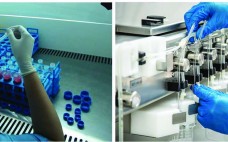On Tuesday, 16 June 2015, Thomas C. Ransohoff (vice president of BioProcess Technology Consultants) chaired a midday roundtable titled, “Stretching for the Trifecta: Innovative Strategies for Speeding Development, Lowering Costs, and Enhancing Quality.” He brought together a panel of four industry experts: Joanne Beck (senior vice president of process development at Shire Pharmaceuticals) Parrish Galliher (chief technology officer for upstream (Xcellerex) at GE Healthcare) Lynne Frick (director of continuous processing for the Americas at Pall Corporation) Mark Brower (senior research…
Manufacturing
The Contractor Perspective: A BPI Theater Roundtable at the 2015 BIO Convention
On Thursday, 18 June 2015, Gil Roth (founder and president of the Pharma & Biopharma Outsourcing Association, PBOA) chaired a midday roundtable titled, “CDMO Challenges and Opportunities.” He brought together a panel of four industry experts: Thomas Thorpe (chief executive officer of Afton Scientific) Michael Riley (vice president and general manager of Catalent Biologics) Victor Vinci (vice president and chief scientific officer for Cook Pharmica) Amit Arora (chief marketing officer at Jubilant HollisterStier) Points of View The Pharma and Biopharma…
Compatibility Assessment of a Model Monoclonal Antibody Formulation in Glass and Blow–Fill–Seal Plastic Vials
PREPRINT October 2015 issue Blow–fill–seal (BFS) technology has been recognized by the industry as an advanced aseptic solution (1–3). Catalent Pharma Solutions has been commercially supplying sterile BFS products to the pharmaceutical industry for decades, primarily in the respiratory and topical ophthalmic markets. Such product formulations range from simple solutions to emulsions with drug substances from classical small molecules to large complex proteins such as biologics. The company also has optimized BFS processes and its Advasept plastic container system for…
Are You Ready for a Tech Transfer? Part 2: Overcoming Obstacles and Implementing Best Practices for Cell Therapy Technology Transfer
In part 1 of this two-part series, we outlined common challenges of technology transfer that are unique to the cell therapy industry and discussed strategies for success (1). Here, we delve even further into best practices and highlight key strategies for technology transfer that should be considered along the path to success. Creating a strong foundation for technology transfer will streamline clinical manufacturing processes and help position therapeutic products for long-term success. Below are key criteria for success. Confirm Transfer…
ISCT Special Report: Advancing Cell Therapy Manufacturing at the 2015 Annual Meeting
The International Society for Cellular Therapy (ISCT) will host its 21st Annual Meeting at Caesars Palace Hotel and Convention Center, Las Vegas, NV, 27–30 May 2015. More than 1,200 industry and regulatory professionals, clinicians, scientists, and laboratory professionals are expected to attend. The program covers six plenary sessions, six workshops, three technical sessions, and more than 20 total track sessions covering such topics as advances in cell therapy research, commercialization strategies, quality and operations, and regulatory issues. BPI spoke with…
Information Instead of Data: User-Friendly HMI Concept Increases Process Control Efficiency
Today, most plant operators are much more than classic process operators. In addition to operational process control, their range of tasks includes product quality assurance, optimization of resources, and maintenance of high‑throughput rates. Qualified information is necessary to reliably perform those tasks. The human–machine interface (HMI) of a process control system provides visualization. Siemens regards new HMI concepts such as advanced process graphics (APG) as the key to task‑specific or situation‑specific decision‑making (Photo 1). Graphics Monitor: the Process Window Before…
BioProcess Theater: Roundtable
Stretching for the Trifecta Innovative Strategies for Speeding Development, Lowering Costs, and Enhancing Quality On Tuesday 16 June 2015, at noon on the BioProcess Theater stage at BIO 2015, Tom Ransohoff (vice president and principal consultant at BioProcess Technology Consultants, Inc.) will moderate a roundtable discussion with the following panelists: Mark Brower (senior research chemical engineer, Merck & Co.) Parrish Galliher (Xcellerex founder and chief technology officer, GE Healthcare) Joanne Beck (senior vice president of process development, Shire) Lynne Frick…
BioProcess Theater: Clinical and Commercial Manufacturing
When it comes to clinical and commercial manufacturing of therapeutic products, outsourcing is an integral part of the biopharmaceutical industry. In the 21st century, product sponsors are increasingly relying on expert contract assistance in process development and production of clinical and commercial materials. Many companies are reaching beyond their local and national borders to extend networks of partnerships into emerging markets, particularly in Asia (1, 2). Most biologics are proteins, with monoclonal antibodies (MAbs) dominating the scene over a number…
Accelerating Affordable Growth: Careful Planning Can Pave the Way for Commercial-Scale Manufacturing
As this special issue of BioProcess International goes to press, an increasing number of cell-based therapies are advancing through preclinical investigation into clinical development and on toward commercialization. Although clinical efficacy will be the primary metric for product approval, the ability to manufacture these therapeutic products consistently, reliably, and cost-effectively will continue to be a key driver and predictor of commercial success. Several articles presented herein describe major issues and challenges facing developers of cell-based therapies. Although some of the…
Planning for Commercial Scale of Cell Therapy and Regenerative Medicine Products, Part 1: Achieving Manufacturability and Managing Cost of Goods
Much mystique and mystery surround the emerging industries of cell therapy and regenerative medicine. As companies progress toward commercial manufacture with potential game changers (e.g., cures for cancer and diabetes) the industry could be on the verge of significant breakthroughs. However, with no real successes to date, the question is raised: What core attributes are required to achieve commercial success? The tale of Dendreon’s struggles highlights how difficult it can be to commercialize even an approved cell therapy product. Since…








